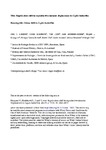Rapid Colour Shift by Reproductive Character Displacement in Cupido Butterflies

Use este enlace para citar
http://hdl.handle.net/2183/35131Coleccións
- Investigación (FCIE) [1172]
Metadatos
Mostrar o rexistro completo do ítemTítulo
Rapid Colour Shift by Reproductive Character Displacement in Cupido ButterfliesAutor(es)
Data
2020-10-13Cita bibliográfica
Hinojosa JC, Koubínová D, Dincă V, et al. Rapid colour shift by reproductive character displacement in Cupido butterflies. Mol Ecol. 2020; 29: 4942–4955. https://doi.org/10.1111/mec.15682
Resumo
[Abstract] Reproductive character displacement occurs when competition for successful breeding imposes a divergent selection on the interacting species, causing a divergence of reproductive traits. Here, we show that a disputed butterfly taxon is actually a case of male wing colour shift, apparently produced by reproductive character displacement. Using double digest restriction-site associated DNA sequencing and mitochondrial DNA sequencing we studied four butterfly taxa of the subgenus Cupido (Lepidoptera: Lycaenidae): Cupido minimus and the taxon carswelli, both characterized by brown males and females, plus C. lorquinii and C. osiris, both with blue males and brown females. Unexpectedly, taxa carswelli and C. lorquinii were close to indistinguishable based on our genomic and mitochondrial data, despite displaying strikingly different male coloration. In addition, we report and analysed a brown male within the C. lorquinii range, which demonstrates that the brown morph occurs at very low frequency in C. lorquinii. Such evidence strongly suggests that carswelli is conspecific with C. lorquinii and represents populations with a fixed male brown colour morph. Considering that these brown populations occur in sympatry with or very close to the blue C. osiris, and that the blue C. lorquinii populations never do, we propose that the taxon carswelli could have lost the blue colour due to reproductive character displacement with C. osiris. Since male colour is important for conspecific recognition during courtship, we hypothesize that the observed colour shift may eventually trigger incipient speciation between blue and brown populations. Male colour seems to be an evolutionarily labile character in the Polyommatinae, and the mechanism described here might be at work in the wide diversification of this subfamily of butterflies.
Palabras chave
Reproductive character displacement
Reinforcement
Speciation
Lepidoptera
RAD-sequencing
Reinforcement
Speciation
Lepidoptera
RAD-sequencing
Descrición
This is the peer reviewed version of the article, which has been published in final form https://doi.org/10.1111/mec.15682
Versión do editor
Dereitos
© 2020 John Wiley & Sons Ltd. This article may be used for non-commercial purposes in accordance with Wiley Terms and Conditions for Use of Self-Archived Versions. This article may not be enhanced, enriched or otherwise transformed into a derivative work, without express permission from Wiley or by statutory rights under applicable legislation. Copyright notices must not be removed, obscured or modified. The article must be linked to Wiley’s version of record on Wiley Online Library and any embedding, framing or otherwise making available the article or pages thereof by third parties from platforms, services and websites other than Wiley Online Library must be prohibited.
ISSN
1365-294X





